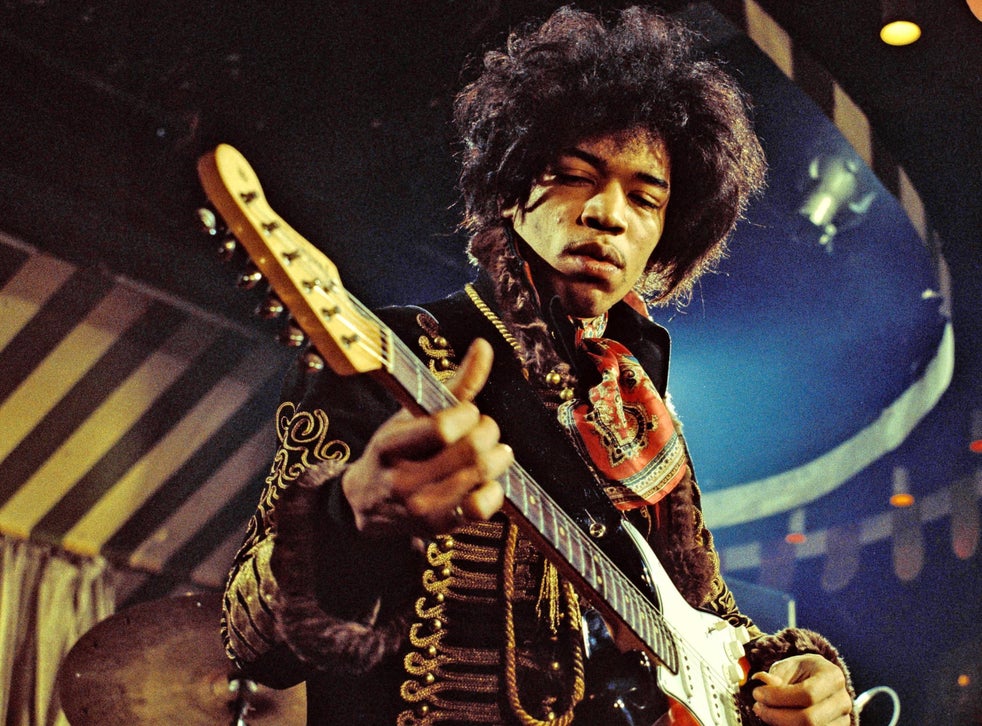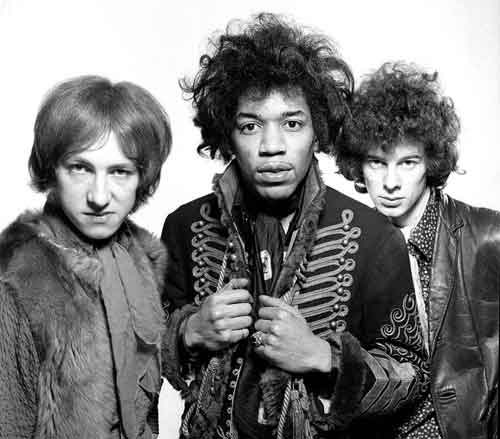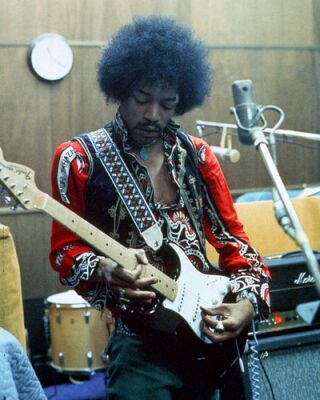
Attention, of course, must (and will) be paid, but the real question remains: what more can possibly be said, at this point, about Jimi Hendrix? Actually, it is entirely fair to propose that we have not yet said enough about him. As it has long since been established that he is the Alpha and the Omega of electric guitar, conversation tends to stop there: what more needs to be said, we say, when we don’t say anything more. As a result, the actual scope of his virtuosity tends to, however unintentionally, get reduced to stock phrases (see above) and the sorts of encomiums that preempt elaboration. So how do we explain the truly singular genius that is Jimi Hendrix? Aside from the innovation (he did it first), apart from the obvious (he did it best), what sets him apart?
When it comes to Hendrix, there is really no conjecture. The growth he displayed in only a couple of years is unlike anything we’ve witnessed from just about any other musician or composer, ever. We’re talking light years, the universe expanding; real quantum type shit. Put it this way: Miles Davis, who didn’t have many good things to say about even the best jazz musicians, made no bones about his desire to get Hendrix in the studio to collaborate. That’s like Michael Jordan saying he’d like to play some pick-up, or Sugar Ray Robinson asking you to spar with him.
Jimi Hendrix has been dead for a long time, and the only thing we have to reconcile the senselessness of how young he died is the legacy he left behind. This is true, of course, with any artist who goes away too soon, except that with Hendrix it is more so. The loss is unparalleled, but then, so is the music he made. Depending on whether you care to see the cosmic glass as more than half-empty or as one that forever runneth over, we celebrate him for what he did in direct proportion to mourning what we still should have received. It is selfish, but understandable. Hendrix with horns in the ’70s? With samples and scratching in the ’80s? Mentoring (or obviating the need for) the grunge movement in the ’90s? Collaborating with musicians from all over the world, releasing live jams on his website today? Or just continuing to do what he was doing practically until the last second he drew breath. Whatever it might have been, it would have improved the playing field, and he would likely still be eons ahead of his peers.
There’s an aesthetic vertigo that only music can so fully and consistently deliver, and –regarding Jimi Hendrix– obliges me to quote T.S. Eliot:
We shall never cease from exploration
And the end of all our exploring
Will be to arrive where we started
And know the place for the first time.

(I’ve attempted to take a measure of Hendrix’s import and influence a few times in the past, overviewing the deluxe editions of his official catalog, along with reviews of box sets Live at Winterland andWest Coast Seattle Boy: The Jimi Hendrix Anthology.)
1967: there are the immutable opening salvos, those hit singles that remain radio-friendly four decades on (“Purple Haze”, “Hey Joe”, “Fire”, “Foxey Lady”) and the moodier harbingers of what lay ahead (“Manic Depression”, “I Don’t Live Today”, “Love or Confusion”) and then there are the outright masterpieces. Consider “The Wind Cries Mary”: written the night before, brought to the studio the next day and captured in one take. An example like this underscores the seismic shift that blasted an unsuspecting world when Are You Experienced hit the streets, the unambiguous arrival of a major, scary talent. But it’s the subsequent embellishment, courtesy of five overdubbed guitar parts, that move this track from mere classic to one-of-a-kind epic: the mood and feeling of melancholy Hendrix conveys calls to mind Poe’s edict about the totality of effect.
Then there’s the psychedelic space jazz of “Third Stone From the Sun”: the ways Hendrix navigates an almost surf-rock elegance with proto-thrash distortion and makes it sound not just natural but inevitable, is part of why the first album continues to merit consideration as the most fully realized debut album in rock history. Finally there is the title track, which truly is one of those instances that defy time and description on so many levels. This song could only have been released in ’67, but it still sounds unsettling and slightly ungraspable in 2010. Perhaps more than any of the other tracks, this one signified the summation of Hendrix’s strategy at that stage: backwards solos, restless feedback and subtly effective piano plinks build up the tension like the song was programmed to detonate. And by the time anybody knew what had hit them; Hendrix was already back in the studio.
Axis: Bold As Love did not have as many instantly accessible singles, but in spite (or because) of that, the second album is unquestionably a major step forward in several regards. This is the disc to slip into any discussion regarding Hendrix’s indisputable, but underappreciated compositional acumen. The guitar is consistently front and center (while Redding and especially Mitchell remain impeccable, as always, in the pocket), but the emphasis on Jimi’s vocals turns purposeful attention on some of the best lyrics he ever penned. While Are You Experienced remains the sonic boom that cleared away all competition, even the best moments on that effort could never in a thousand years have anticipated songs like “Little Wing”, “Castles Made of Sand”, “One Rainy Wish” and “Bold As Love”. (Even an ostensibly throwaway tune like “She’s So Fine” is instructive: Jimi’s lightning leads and delectable falsetto choruses shine, but then there’s Mitch Fucking Mitchell. Only one drummer in rock was this fast and furious circa 1967 and his name was Keith Moon.)
The songs on Axis: Bold As Love, for the most part, are concise and unencumbered (the clarity of sound on these remasters more than justifies their acquisition), and this is in no small part due to producer (and then manager) Chas Chandler, who brought a strictly-business professionalism to the proceedings all through ’67. He explains his old school M.O. on the companion DVD: “If a band can’t get it in two or three takes they shouldn’t be in the studio.” How can you not love this guy? And watching Eddie Kramer at the console, isolating guitar tracks and vocals while recalling how the songs came together is a treat true Hendrix fans will lap up like voodoo soup. Indeed, the only gripe about the bonus DVDs is their brevity; I could easily listen to Kramer and Chandler tell war stories for hours on end without getting bored, and I’m certain I’m not alone.
There’s also an air of adventure and daring that augments the sometimes disorienting edge of the debut. Hendrix is clearly pushing himself, each day coming up with new ideas and electrified with the air of possibility. That vision is convincingly and definitively realized, and we can only lament the comparatively primitive technology that prevented alternate takes from surviving the sessions. Imagine, for instance, where “Little Wing” continued to go after the tapes fade out. If there is one particular moment on any of these tracks that best illuminates Hendrix’s insatiable creativity and unerring instincts, it comes toward the end of the incendiary “If 6 Was 9”. After declaring, in one of the all-time great rock and roll F-offs (“I’m gonna’ wave my freak flag high!”), a sort of whinnying, high-pitched noise slips into the maelstrom. Kramer explains that there happened to be a recorder lying around the studio, and Hendrix simply picked it up and started wailing. Kramer then applied the appropriate effects and echo, and the rest is history. In the final analysis, there is no way to improve upon practically any part of Axis: Bold As Love: this is as good as music is capable of being.
By 1968 Hendrix has relocated from London to New York City and it was during the open-ended and generally unrestrained Electric Ladyland sessions that Chandler, ever the taskmaster, famously fled the scene. “Gypsy Eyes” alone allegedly required forty different takes before Hendrix was satisfied, an intensity surpassing obsession that literally drove Chandler out of the studio. This circumstance was inevitable, and frankly necessary. Hendrix absolutely needed and benefited from Chandler’s mentoring, but now he had more than come into his own and nobody could keep up with him (he could scarcely keep up with himself). The results scream for themselves and to say that Electric Ladyland is yet another major advancement (how do you improve upon perfection?) is of course a pallid understatement.

Just as little from Are You Experienced hinted at the next installment, Axis: Bold As Love seems almost pedestrian and conservative compared to the staggering triumph of style and sound that is Electric Ladyland.
This is Hendrix’s masterpiece, and it is on this double album that practically every trick in his oversized bag is employed to its fullest extent. The storytelling skills are displayed on tracks like “Crosstown Traffic”, “Long Hot Summer Night” and “House Burning Down”. The compositional prowess is evident in every note, most especially on the song suite that covers side three and spills over to side four. What Hendrix was able to achieve, despite the contemporary limitations of old-fashioned recording equipment is, on a song like “1983… (A Merman I Should Turn To Be)”, heroic. It also offers the best evidence we have of what he saw and heard inside his always-teeming imagination.
What remains vital, and compelling, all these years later is the way Hendrix appropriates blues music, creating a template that copycats are still trying, in vain, to emulate. “Voodoo Child (Slight Return)” and the live-in-the-studio riot of “Voodoo Chile” are rock music touchstones, and nothing anyone has attempted has come particularly close to them. Hendrix himself puts it best when he boasts “Well I stand up next to a mountain/And chop it down with the edge of my hand.” That is exactly what he did, and he remains king of the mountain he scaled, and then razed.
From “Purple Haze” to “Rainy Day, Dream Away” in less than two years still seems inconceivable, even impossible. But it happened. And, of course, Hendrix continued to broaden his scope and incorporate more styles and sonic experiments (check out the full, funky brass accompaniment on the title track from South Saturn Delta), pushing past the boundaries he had already blown away. The material collected on First Rays of the New Rising Sun represent many of the songs Hendrix was assembling for another double album in the summer over 1970, just before his death. Noel Redding is gone and Billy Cox, having already worked with Mitchell and Hendrix during the Valley of Neptune sessions, is a liberating presence that allows the band to spread out and chase the guitarist as he soars above, around and beneath them. With all due respect to Noel Redding — and nevermind the rumors that Hendrix simply played all the bass parts himself — one of the tantalizing prospects remains what avenues would have continued to open with Cox freeing Mitchell to incorporate his jazz stylings into the mix.
Back to the genius thing and how to wrap our minds around the extent of Hendrix’s gifts: Eddie Kramer analyzes “Dolly Dagger” and uses the console to demonstrate the fastidious attention Hendrix devoted to every second of every song, down to his ability to multi-track his own vocals, knowing in advance exactly where each note and inflection was meant to go. When Kramer isolates the guitar tracks on “Night Bird Flying”, it’s not just a matter of how great each one sounds and the ways they complement each other; it’s more the uncanny way each one could easily and convincingly stand alone as a fully formed statement. Many of the songs, like “Izzabella”, “Stepping Stone”, “My Friend”, “Straight Ahead” and “Astro Man” are loose and as light as Hendrix had been since some of the tracks on Axis: Bold As Love. Then there are irrepressible gems like “Ezy Ryder”, “Dolly Dagger” and “Belly Button Window” that bring the band directly into a new decade. Most of the material has a fresh and unfettered sound: much less overdubbing and Hendrix’s infatuation with “phasing” — which he took to its logical limits on Electric Ladyland (think “Moon, Turn the Tides…Gently Gently Away”) — is now discarded in favor of a more straightforward assault. This direction is nicely encapsulated in the instrumental “Beginnings” where there are no frills or tricks, only a scorching a workout that showcases Hendrix’s ability to create fire with any smoke.
Of course, there are also a handful of tracks that elevate themselves above the rest and go to that other place. “Freedom”, the perfect album opener, is just a clinic of where rock and roll had gone, and where it might have continued to go; “Room Full of Mirrors” is a tour de force of multi-tracked guitar bliss (including cowbell!) and “Hey Baby (New Rising Sun)” is, or will have to be, as suitable a farewell statement (“May I come along?”) as we could hope for. And finally, the one-two punch of “Drifting” and “Angel”, that, not that it’s necessary to quantify, might represent the most beautiful work Hendrix ever recorded. Inevitably, some measure of outright hyperbole is unavoidable: if there is such a thing as beyond perfection, it is achieved on “Angel” and “Drifting”.
And then he was gone. The magnitude of his loss remains unfathomable. There is no question, absolutely no doubt whatsoever, that he had years and years of untapped magic to explore and nourish. On the other hand, perhaps Hendrix did live and record for four decades; he just crammed it into four years. Hendrix and the gift of his music are subjects that can never be exhausted: the songs hold up, they should be studied and dissected, and above all they should be savored. They are, like the man who made them, incapable of ever being forgotten.
In the end, it always comes back to the same impasse: once we’ve gotten beyond the music (which we never get beyond, because, thus far, there has always been new material, causing us to celebrate our good fortune and hope we might get more) we catch ourselves asking the two questions that can never be answered: why and what. Why did it have to end so abruptly, so appallingly? And then, if and when we allow ourselves, the attempt at imagining what else there could have been… what else he would have left for us if he had not accidentally left us behind?
